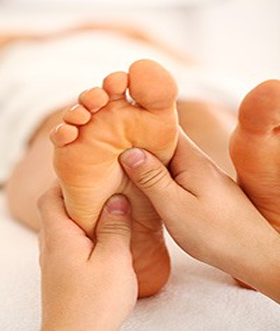|
There were limb dysfunction in 26 patients and motor aphasia in 7 patients. Foot reflexo-therapy was applied for 30 minutes daily, with 10 days as one course of treatment. The period of treatment ranged from 2 to 7 months. It is reported that after treatment, 11 patients (33.33%) were cured: symptom free, with normal limb function and independent daily life; 20 patients (60.61%) improved: symptom free with improved limb function; and 2 patients (6.06%) were unchanged: no improvement in symptoms and limb function. It was concluded that foot reflexo-therapy can restore the damaged brain function, and revive the limb and speech performance of patients with cerebral thrombotic sequelae [stroke]. It was also proposed that foot reflexo-therapy is useful in the prevention of cerebral thrombosis, as well as in the treatment.’
These results are supported by previous studies on movement and speech in China, which also concluded that reflexology can significantly help people to recover after a stroke.4
Another study, published in 2005, asked whether reflexology could make a difference to activities of daily living(ADL) and fatigue after a stroke. Thirty-one stroke survivors were treated with 40 minutes of reflexology twice a week for six weeks. Tests showed:
‘After foot reflexology, the subjects in the experimental group showed significant improvement in ADL. They also had less physical, psychological, and neurosensory fatigue, which are three areas of fatigue.’
A study published in 2009 contradicts some of the findings we have discussed. Dr Edzard Ernst, Director of Complementary Medicine at the Peninsula Medical School in the UK, conducted an extensive review. He concluded that there is little or no evidence to show that reflexology has any effect on any medical condition. He reviewed 217 trials on the benefits of reflexology for a range of symptoms and conditions. He dismissed 199 trials because he was not satisfied that they were of sufficient size or quality, and excluded their findings. He explains:
‘Of these 18 remaining studies, 12 failed to show convincingly that reflexology is an effective treatment, five suggested positive effects and the direction of one result was unclear. “Most higher-quality trials did not generate positive findings.”’6
Although Dr Edzard Ernst is based on the United Kingdom, he chose to publish his findings in the Medical Journal of Australia. When we consider the findings of any international systematic review, we should remember this: different countries may have different research criteria, which means that a clinical trial might be accepted by one national association but not by another. For example, also in 2009, The National Institute for Clinical Excellence (NICE) in the United Kingdom ‘“partially endorsed” the value of reflexology in Multiple Sclerosis care following ten years of research projects’.7 This might go some way towards explaining the different conclusions of Dr Ernst’s review, presented in Australia, compared with the review prepared by Dr Liang, presented in China.
Source: http://researchandhope.com/reflexology/
|
 Comfort Hand
Comfort Hand